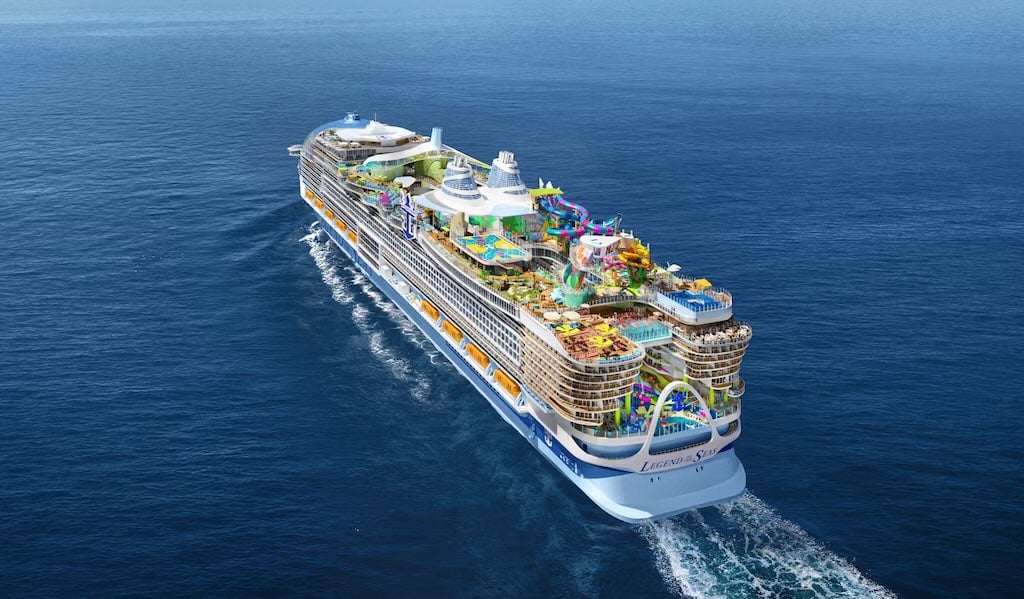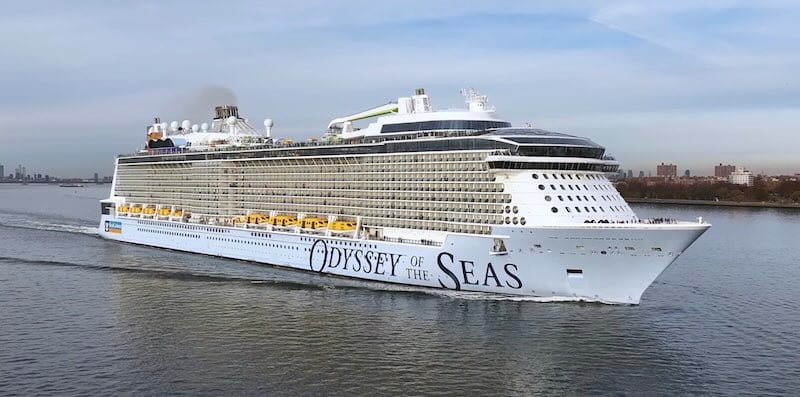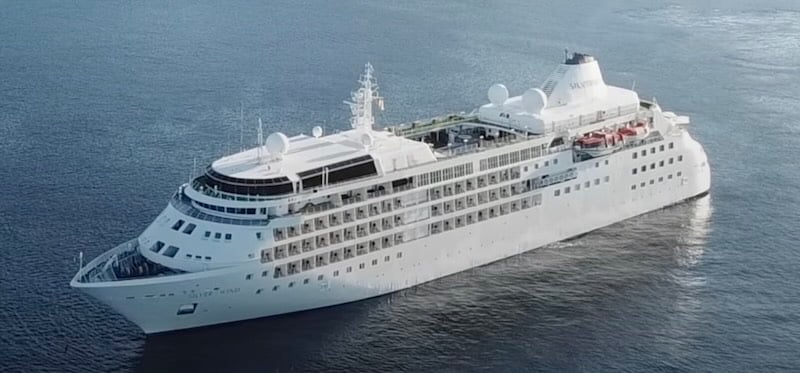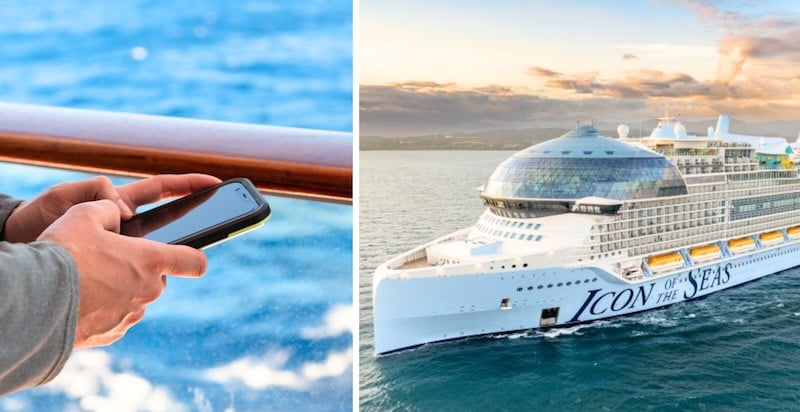When Titanic set sail in 1912, it was hailed as the largest and most luxurious ship the world had ever seen. Over a century later, Royal Caribbean’s Star of the Seas has taken cruising to an entirely new level. At nearly five times the size of Titanic, this mega-ship is essentially a floating city, packed with more restaurants, pools, and entertainment than some towns on land.
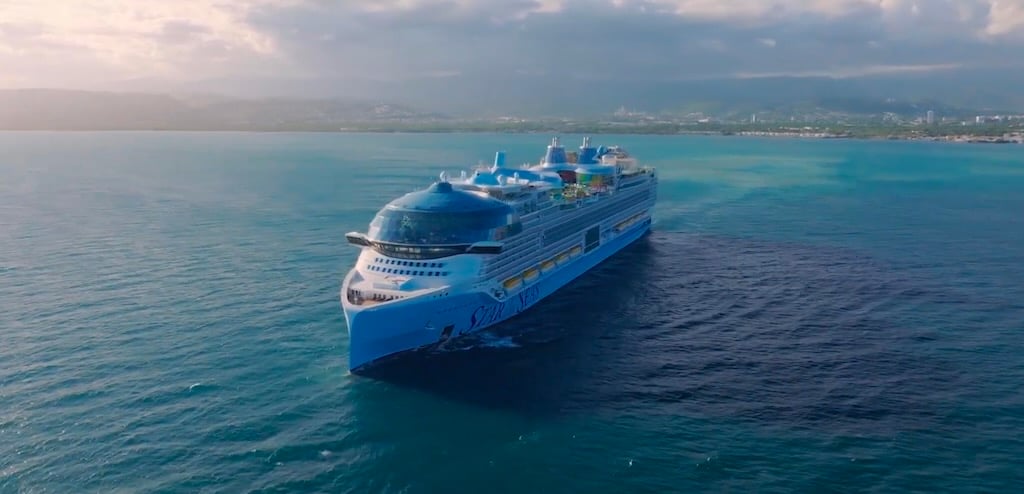
But how exactly do these two famous ships compare? From sheer size and passenger capacity to safety features and ticket prices, this guide breaks down Star of the Seas vs Titanic to show just how far cruising has advanced in the last hundred years.

Table of Contents
Star of the Seas vs Titanic – Size and Dimensions
When it comes to sheer size, there’s simply no contest. Star of the Seas is one of the largest cruise ships ever built, while Titanic, though enormous for its time, would look small docked alongside her.
- Star of the Seas: about 248,663 gross tons (GT), stretching 1,198 feet in length and 213 feet wide.
- Titanic: 46,328 GT, measuring 882 feet long and 92.5 feet wide.
That means Star of the Seas is more than five times larger in volume and about 35% longer than Titanic. To put that in perspective, Titanic could practically fit inside Star of the Seas multiple times over.
Here’s a quick snapshot side by side:
| Ship | Gross Tonnage | Length | Width | Guest Decks |
|---|---|---|---|---|
| Titanic | 46,328 GT | 882 ft | 92.5 ft | 9 |
| Star of the Seas | 248,663 GT | 1,198 ft | 213 ft | 20 |
Star of the Seas vs Titanic – Passenger & Crew Capacity
If Titanic amazed the world with her ability to carry more than 3,000 people, Star of the Seas absolutely dwarfs her.
- Titanic: about 2,435 guests with 892 crew members (around 3,327 people total).
- Star of the Seas: up to 7,600 guests with 2,350 crew members (a staggering 9,950 people total).
That means Star of the Seas sails with three times more passengers and nearly three times the crew support compared to Titanic.
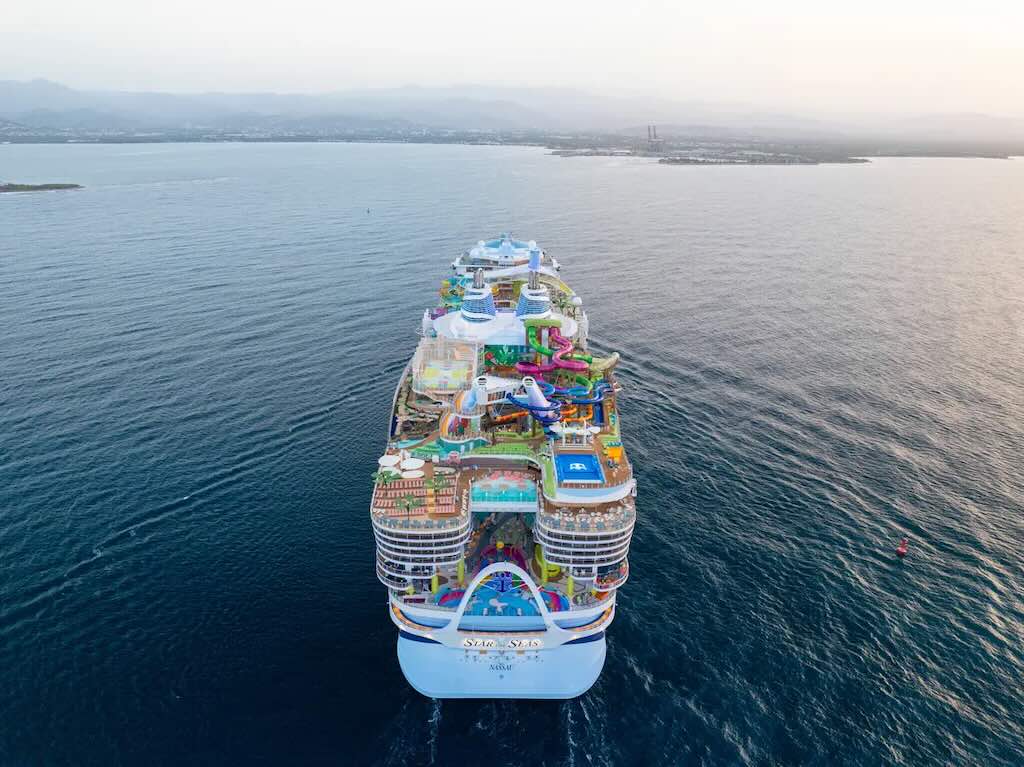
Onboard experience is also completely different. Titanic was divided by strict class systems, with first-class passengers enjoying extravagant dining rooms while third-class guests had far fewer comforts. On Star of the Seas, guests of every cabin category can enjoy world-class entertainment, multiple pools, and dozens of dining choices.
Star of the Seas vs Titanic – Speed and Power
Here’s a fun surprise: despite being over five times bigger, Star of the Seas cruises at almost the same speed as Titanic.
- Titanic: cruising speed of 21 knots (about 24 mph), with a top speed of 23 knots.
- Star of the Seas: cruising speed of 22 knots (about 25 mph), with a similar maximum.
The big difference comes down to how they achieved that speed.
- Titanic relied on coal-fired boilers and needed massive amounts of manpower to shovel fuel around the clock.
- Star of the Seas uses liquefied natural gas (LNG), making it far cleaner, more efficient, and environmentally friendly.
While speed isn’t a major selling point for today’s cruise ships, the fact that a 250,000-ton giant like Star of the Seas can keep pace with Titanic shows just how far marine engineering has come.
Star of the Seas vs Titanic – Facilities & Amenities
This is where the differences between the two ships really shine. What was once considered the height of luxury in 1912 now feels surprisingly simple compared to today’s floating resorts.
Swimming Pools & Water Fun
- Titanic: had one swimming pool, available only to first-class passengers, and it was separated by men’s and women’s time slots.
- Star of the Seas: features seven pools, including the first-ever infinity pool at sea, plus nine whirlpools and a full-scale waterpark with high-speed slides.
Dining Options
- Titanic: four restaurants — the Dining Saloon, A la Carte Restaurant, Verandah Café, and Café Parisien. Meals reflected class divisions, with the finest French-inspired cuisine reserved for first class.
- Star of the Seas: over 20 dining venues ranging from upscale specialty restaurants to casual grab-and-go eateries. Guests can sample global cuisines daily without ever repeating the same menu.
Entertainment & Activities
- Titanic: entertainment meant card games, dominoes, shuffleboard, and the squash court. Music came from live orchestras in the lounges.
- Star of the Seas: offers rock climbing walls, surf simulators, mini-golf, Broadway-style shows, an AquaTheater, arcades, laser tag, and a full carousel. It’s not just a cruise ship — it’s an amusement park at sea.
Accommodation
- Titanic: first-class suites offered elegant sitting rooms, faux fireplaces, and private bathrooms, but third-class cabins were often shared and lacked amenities.
- Star of the Seas: has 2,805 staterooms, ranging from budget-friendly inside cabins to lavish suites like the Ultimate Family Townhouse, complete with a slide, private patio, and even a mailbox.

Star of the Seas vs Titanic – Safety Then vs Now
No comparison between these two ships is complete without looking at safety. Titanic is remembered not for its grandeur, but for the tragedy of April 1912 when it struck an iceberg and sank on its maiden voyage.
Lifeboats & Evacuation
- Titanic: carried 20 lifeboats, enough for about 1,178 people out of the more than 2,200 onboard. Regulations at the time only required lifeboats for a fraction of passengers, a mistake that proved catastrophic.
- Star of the Seas: has lifeboats large enough to hold every single guest and crew member onboard. Modern ships are legally required to carry life-saving equipment for at least 125% of capacity.
Fire Safety & Engineering
- Titanic: relied on watertight compartments, but once too many flooded, there was no backup system. Fire suppression was limited, and coal dust itself created a hazard.
- Star of the Seas: is equipped with state-of-the-art fire suppression systems, advanced water mist sprinklers, and multiple redundant safety features built into every deck.
Navigation & Technology
- Titanic: used the latest 1912 technology — a Marconi wireless radio and lookouts with binoculars (which were famously not available the night of the iceberg).
- Star of the Seas: features radar, GPS, satellite communications, and real-time iceberg and weather tracking, plus highly trained bridge officers working with digital command systems.
Today’s cruise ships are far from “unsinkable,” but they are designed to minimize risks from fire, storms, or even grounding. The lessons learned from Titanic helped shape modern safety regulations, making ships like Star of the Seas safer than ever before.
Star of the Seas vs Titanic – Cost to Build
The price tag is another area where the gap between Titanic and Star of the Seas is staggering.
- Titanic: cost about $7.5 million in 1912. Adjusted for inflation, that’s roughly $200 million in today’s money.
- Star of the Seas: estimated construction cost of around $2 billion.
That makes Star of the Seas at least ten times more expensive than Titanic, even after adjusting for inflation.

Why such a huge difference? Modern cruise ships are essentially floating resorts filled with advanced technology, theaters, waterparks, luxury suites, and sustainable LNG engines. Titanic was revolutionary for its time, but its construction focused primarily on speed, comfort for first-class guests, and transatlantic travel rather than resort-style amenities.
Star of the Seas vs Titanic – Ticket Prices Compared
Cruising has always ranged from affordable escapes to ultra-luxury splurges, but the difference between Titanic and Star of the Seas really shows how times have changed.
Cheapest Tickets
- Titanic: the lowest-priced third-class tickets were about £7 in 1912, which equals roughly $900 in today’s money.
- Star of the Seas: a 7-night Caribbean cruise starts at around $731 per person.
That means, surprisingly, it can actually be cheaper to cruise today than it was in Titanic’s time.
Luxury Suites
- Titanic: first-class parlour suites cost £870 in 1912, or about $104,000 today. These came with two bedrooms, a private bathroom, and a sitting room with fine woodwork and a faux fireplace.
- Star of the Seas: the Ultimate Family Townhouse can run $85,000 for a week during holiday sailings, and it comes with three levels, a slide, private balcony, and even a backyard-style patio.
So while luxury cruising is still eye-wateringly expensive, Star of the Seas actually undercuts Titanic when you adjust for inflation. And unlike 1912, the average family today can afford cruising, which has made it one of the most popular vacation styles in the world.

Star of the Seas vs Titanic – Design & Engineering Advances
Shipbuilding has changed dramatically in the last century. Titanic was the pinnacle of Edwardian engineering, but Star of the Seas shows just how much innovation has transformed cruising.
Materials & Construction
- Titanic: built primarily with riveted steel plates and a double-bottom hull. It was cutting-edge at the time, but rivets proved to be a weak point when the ship struck the iceberg.
- Star of the Seas: constructed with welded steel and advanced alloys, making the hull stronger and more flexible. Computer-aided design and stress testing ensure the ship can withstand rough seas far better than early 20th-century liners.
Power & Propulsion
- Titanic: relied on coal-fired boilers powering steam engines and a turbine. This required huge amounts of manpower and produced significant pollution.
- Star of the Seas: powered by LNG (liquefied natural gas), one of the cleanest fuels available for ships. She also uses pod propulsion systems for efficiency, maneuverability, and reduced vibration.
Environmental Impact
- Titanic: environmental concerns were not a factor in 1912. Coal smoke and waste simply went into the ocean or air.
- Star of the Seas: includes energy-saving systems, advanced water treatment plants, and reduced emissions technologies to meet strict international regulations.
In short, what was once a marvel of human achievement is now a reminder of how far naval engineering and sustainability have advanced.
Star of the Seas vs Titanic – Cultural Impact
The story of Titanic is etched into history, while Star of the Seas represents the height of modern cruising. Both ships carry cultural weight, but in very different ways.
Titanic’s Legacy
Titanic wasn’t just a ship — it became a symbol of human ambition and tragedy. Its sinking in 1912 shocked the world, reshaped maritime safety laws, and inspired countless books, museums, and of course, the blockbuster 1997 film. To this day, Titanic captures the imagination as the most famous ship in history.
Star of the Seas as a Modern Icon
Star of the Seas, meanwhile, embodies the future of cruising. It’s marketed as the ultimate family vacation, offering theme-park-level attractions, luxury suites, and entertainment for nearly 10,000 people at once. Instead of symbolizing tragedy, it represents progress, innovation, and the rise of cruising as one of the world’s most popular vacation choices.
Where Titanic was about exclusivity and class divides, Star of the Seas is about inclusivity, family fun, and creating a floating destination that rivals land resorts.
Star of the Seas vs Titanic – Quick Comparison Chart
Here’s a side-by-side look at the key stats:
| Feature | Titanic (1912) | Star of the Seas (2025) |
|---|---|---|
| Gross Tonnage | 46,328 GT | 248,663 GT |
| Length | 882 ft | 1,198 ft |
| Width | 92.5 ft | 213 ft |
| Guest Decks | 9 | 20 |
| Passengers | 2,435 | 7,600 |
| Crew | 892 | 2,350 |
| Total Capacity | ~3,327 | ~9,950 |
| Cruising Speed | 21 knots | 22 knots |
| Top Speed | 23 knots | 23 knots |
| Pools | 1 | 7 |
| Dining Venues | 4 | 20+ |
| Construction Cost | $7.5M (≈$200M today) | ≈$2B |
| Cheapest Ticket | ≈$900 today | ≈$731 today |
| Most Expensive Suite | ≈$104,000 today | ≈$85,000 |
Jim’s Take – What This Comparison Really Shows
Every time I compare a modern cruise ship to Titanic, I can’t help but be amazed at how far we’ve come. Titanic was the crown jewel of 1912, yet compared to Star of the Seas, it feels almost quaint. What once passed as ultimate luxury — a single pool, four restaurants, and a squash court — has now been replaced with waterparks, Broadway shows, robotic bartenders, and entire neighborhoods at sea.
What stands out most to me is the accessibility. Titanic’s finest suites were reserved for society’s elite, costing the equivalent of more than $100,000 in today’s money. On Star of the Seas, families can book a balcony cabin for less than a theme park vacation. Cruising has gone from being a luxury for the few to a vacation for the many.
For me, that’s the biggest story behind Star of the Seas vs Titanic: not just the size difference, but how cruising has evolved into something safer, more entertaining, and — believe it or not — more affordable than ever before.
If this fascinates you, don’t miss my deep dives into:

